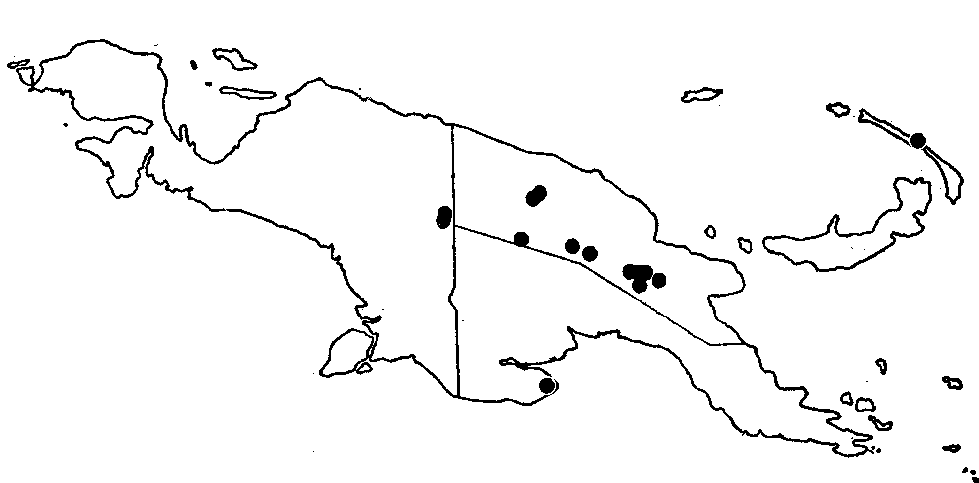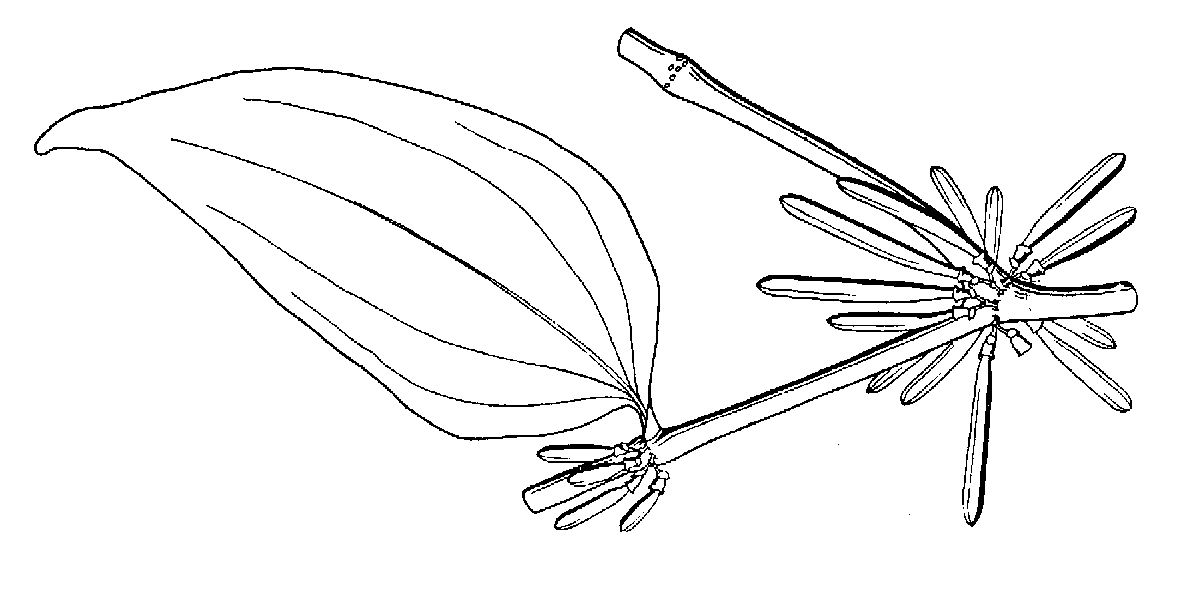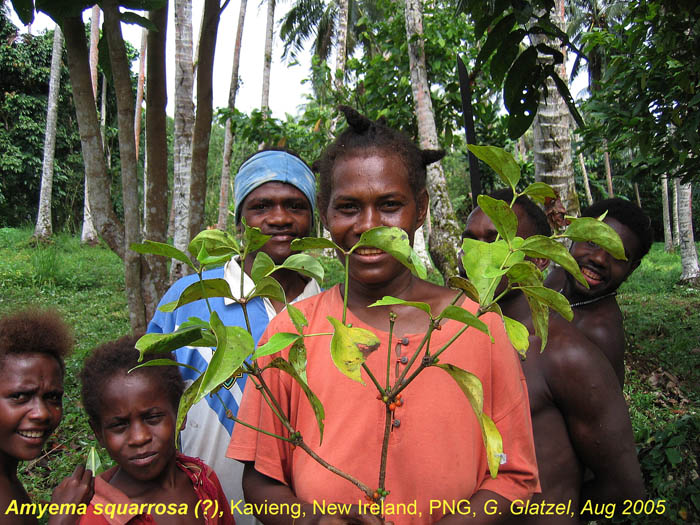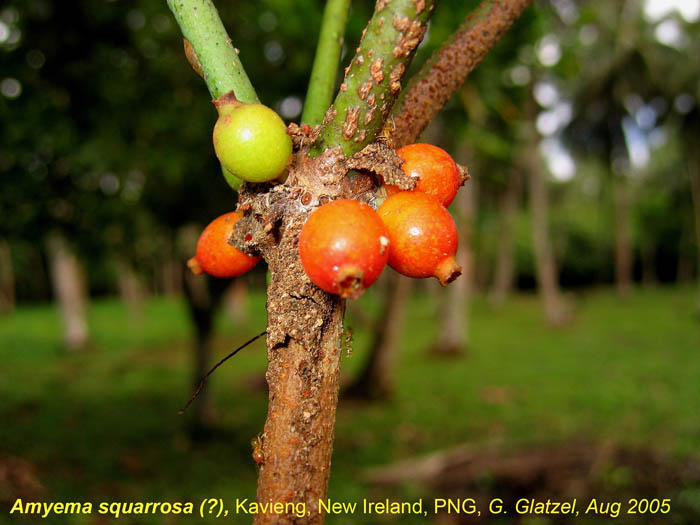
Distribution Map (Barlow 1974)

Note that subspecies rhopalanthes is no longer recognized as a distinct entity.
Description (Barlow 1992)
Loranthus squarrosus Krause, Bot. Jahrb. Syst. 57 (1922) 485. - Amyema squarrosa (Krause) Danser, Bull. Jard. Bot. Buitenzorg III, to (1929) 299. - Type: Ledermann 10377 (lecto L 941,17480, see below; iso K), New Guinea, Sepik Region, Lordberg, 1000 m, 1912-1913.
Amyema rhopalanthes Danser, Brittonia 2 (1936) 134. -Amyema
squarrosa subsp. rhopalanthes (Danser) Barlow, Austral.
J. Bot. 22 (1974) 592. - Type: Brass 5782 (holo NY; iso
L 936,139511, L 946,294-170), New Guinea, Papua, Oriomo R., Wuroi,
5 m, i-iii.1934.
For descriptions see Danser, Bull. Jard. Bot. Buitenzorg III,
11 (1931) 348; Barlow, Austral. J. Bot. 22 (1974) 591. Along with
the closely related and sympatric A. seemeniana, the species
is distinct from most of its congeners in its inflorescence which
is a slender, pedunculate, 2-flowered simple umbel, bearing flowers
with a thin inflated corolla in which the petals may remain coherent
for some time after anthesis. The reduced inflorescence is probably
a parallel development to other simple umbels in the genus (see
notes under Amyema above and under A.fasciculata andA.
sanguinea). For differences from A. seemeniana, see
there. The flower colour is variable, often described as various
shades of red from pale pink to darlc red or pale to dark orange,
often having these colours in the lower part and being paler,
or green or yellow above.
The species occurs in New Guinea (fig. 15; 14 collections seen),
mostly in highlands at elevations from 1000 to 1060 m, but has
also been recorded in the Fly River lowlands. Habitat details
are poorly known, but the species apparently occurs in rain forests.
The only recorded host is Saurauia.
Barlow (1974) recognized two subspecies,
squarrosa and rhopalanthes. The latter subspecies
differs only in an apparently more strongly inflated corolla,
but is disjunct geographically and altitudinally. Further examination
of the type material in the present study indicates that there
are no real differences in corolla inflation, and notwithstanding
the geographic disjunction, subsp. rhopalanthes cannot
be sustained as a distinct entity.
The holotype of Loranthus squarrosus (B) is no longer extant An isotype in L has been seen and designated lectotype of the name. An isotype in K has also been seen.
For comment on the possible identity of the doubtful species A. curvifolia, see note under A. hastifolia.
Description (Barlow 1974)
Amyema squarrosum (Krause) Dans. Bull. Jard. bot. Buitenz. 10: 299 (1929); 11: 348 (1931); Loranthus squarrosus Krause, Bot. Jahrb. 57: 485 (1922). Type-New Guinea, Lordberg, Sepik region, 1000 m alt., Ledermann 10377, 1912-1913 (B, holotype, not seen, probably destroyed; L 94117480; K).
Amyema rhopalanthes Dans. Brittonia 2:134, illus. t. 1, h (1936). Type.-Wuroi, Oriomo R., Papua, P m alt., Brass 5782, Jan-Mar. 1934 (NY, holotype; L 936139511; L 946294170).
Glabrous or the inflorescence calyx and sometimes the corolla sparsely brown-tomentose. Leaves opposite; petiole flat or channelled above, 4-9 mm long; lamina lanceolate to broadly ovate, more or less oblique, 8-18 by 2.5-6 cm, abruptly attenuate at the base, acuminate and acute at the apex; venation distinct and raised below, often depressed above, nearly curvinerved but with some lateral veins arising near the base of the midrib. Inflorescences several in the axils, each consisting of a simple 2-flowered umbel; peduncle obscure or up to 1 mm long (or slightly longer in fruit); pedicels 2-4 mm long, 0.7 mm wide; bract erect, conspicuous, nearly encircling the apex of the pedicel, mostly acute and 1-2 mm long, rarely expanded up to 5 mm long. Calyx barrel-shaped to strongly funnel-shaped; limb erect, truncate or weakly lobed, c. 1 mm long. Corolla in the mature bud slender to inflated, thin, 2.5-3.6 mm long, 5-merous. Anthers 25-3 mm long; free parts of the filaments 6-7 mm long. Stigma capitate, twice as wide as the style. Fruit urceolate, truncate, not seen mature.
Occurrence. New Guinea, from the Star Mts. to Mt. Michael (Fig. 6), (1000)- 1850-2450 m altitude, and also Western Papua, near sea level.
A. squarrosum is closely related to A. seemenianum, and is distinguished by the very short or obscure peduncle, the slightly penninerved leaf and the other smaller differences evident in the descriptions. There is probably only slight overlap in the geographical distributions of the two species, and they are probably recent differentiates from a common stock. The variation in the complex is illustrated by the two species comprising between them five subspecies.
Key to Subspecies of Amyema squarrosum
1. Corolla cylindrical 25a. Subsp. squarrosum
1. Corolla strongly inflated
at the apex 25b. Subsp.
rhopalanthes
25a. Subsp. squarrosum
Corolla cylindrical. Other characters are as set out in the species description.
Occurrence. New Guinea, from the Star Mts. to Mt. Michael (Fig. 6), usually from 1850 to 2450 m altitude but rarely found down to 1000 m.
Representative Specimens. EASTERN NEW GUINEA: Betabib, Star Mts., 1200-1300 m alt., Kalkman and Vervoort 4276, 13.vi.1959 (L; CANB); Mt. Michael, W. slopes, 1940 m alt., Brass 31154, 25.viii.1959 (cANB; K; L).
25b. Subsp. rhopalanthes (Dans.) Barlow, comb. et stat. nov.
Amyema rhopalanthes Dans., Brittonia 2:134, illus. t. 1, h (1936). Type.-Wuroi, Oriomo R., Western Division, Papua, P m alt., Brass 5782, Jan-Mar. 1934 (NY, holotype; [936139511; L 946294170).
Corolla strongly inflated at the apex. Other characters are as set out in the species description.
Occurrence. New Guinea; Western Division, Papua (Fig. 6), P in altitude.
Specimen Examined. EASTERN NEW GUINEA: Wuroi, Oriomo R., Western Division, Papua, 5 m alt., Brass 5782, Jan-Mar. 1934 (NY; L).
The morphological difference between the two
subspecies is rather slight, but in view of the striking geographic
and altitudinal separation involved, it provides a sufficient
basis for the distinction of the subspecies.

Amyema squarrosum ssp. rhopalanthes (as A. rhopalanthes). Twig with leaf and inflorescence. From Danser (1936, Brittonia 2: 131-134).

Amyema squarrosa (possibly). Fruiting shoots. Kavieng, New Ireland, Papua New Guinea. Photo by G. Glatzel August 2005.

Amyema squarrosa (possibly). Close-up of fruits. Kavieng, New Ireland, Papua New Guinea. Photo by G. Glatzel August 2005.
Amyema squarrosa
updated 22 January 2007